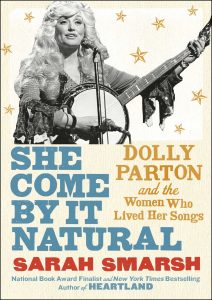OCTOBER
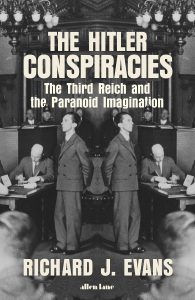
Richard J. Evans, The Hitler Conspiracies
Oxford University Press, October 1
In a time when every other macro-aggression of the Trump administration is being compared to the Reichstag fire, this mesmerizing new book by leading Weimar historian Richard J. Evans ought to be key reading. Moving through Hitler’s life, he exposes the way certain events pulled away from the facts and became more than myths, but conspiracies. –John Freeman, Executive Editor
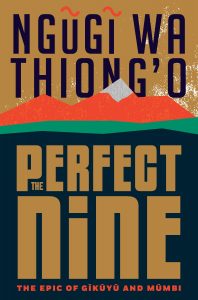
Ngugi Wa Thiong’o, The Perfect Nine
New Press, October 6
In his lifetime, Ngugi Wa Thiong’o has shucked off a colonial name and language, reinvented drama as a form, chronicled the rise of independence in his young nation, suffered in prison as a result—where he wrote a novel on toilet paper—and resurrected his pre-colonial language. All that before counting in the fact that he has carved open a space for African writing through which dozens of our most talented young writers emerged. So finding a new form then is something he does in between tea and dinner. The Perfect Nine shows just how effortlessly he can switch from his conventional modes like autobiography—such as in his recent series of memoirs of a public life lived—into something huge, old and new at the same, such as this epic.
Unfolding in wry and lyrical verse, The Perfect Nine tells a Homeric odyssey of the creation of the entire Gikūyū people—a creationist myth, an adventure tale, and a family story, wherein the wives do not simply wait at home. Gikūyū and Mumbi have been guided to Africa by the Great Creator, and settle in Nyagathanga, where they marvel at the rich valley, its stately hills, and the possible future it holds for their ten daughters (one remains un-counted for reasons which are protective). Their nine goddess-like daughters are ready to make lives of their own, and word has spread of their feats, so 99 suitors begin to come. Then the fireworks begin. –John Freeman, Executive Editor
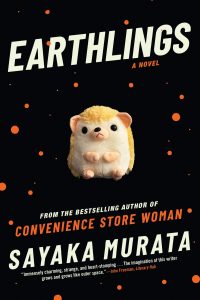
Sayaka Murata, tr. Ginny Tapley Takemori, Earthlings
Grove, October 6
If you want to return to that time in your youth when everything is enchanted with otherworldly meaning, you should pick up Sayaka Murata’s Earthlings. Gorgeously translated by Ginny Tapley Takemori, this novel tells the story of Natsuki, a young girl and social outcast with a big heart. (She’s the scapegoat, the black sheep in her family, and the gut-wrenching thing is, she knows it: “The phrase ‘close-knit family,’ which I’d come across in a school library book and had stuck in my mind, always came back to me when I saw my parents and sister together.”) Her best friend is a toy hedgehog named Piyyut who discloses to her that he has come into her life to help her save her planet. Her saving grace—the thing she waits for all year—is the big family gathering hosted at her grandmother’s house on the mountain. Here, she gets to see her cousin, who is also an alien. (Read: also an outcast.) This is a story about the way we cope with things beyond our comprehension. The heartbreaking thing is their earnestness, the way they see the world versus the things the reader can see happening under the surface. But it is also a joy to see the world through Natsuki’s eyes. Sayaka Murata (author of the mesmerizing Convenience Store Woman) has a special gift for stripping away familiarity from our world (as an adult, Natsuki views her society as a “baby factory” and her city as “nests packed closely together”). Earthlings is a gem, a glimpse at our world not quite reflected but refracted back at us in the most interesting light. –Katie Yee, Book Marks Associate Editor
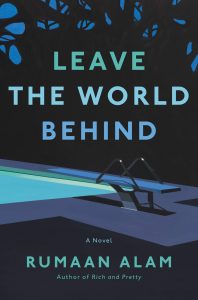
Rumaan Alam, Leave the World Behind
Ecco, October 6
I’m currently in the middle of Rumaan Alam’s novel about two families—one white, one Black, and strangers to each other—stuck in a vacation home together amid (yes, amid) an unspecified disaster, so forgive me if I keep this brief. I’m absolutely gripped and I need to get back to it. I’ll say that it’s a beautifully paced page-turner that never sacrifices prose for plot, or vice versa, and that it’s both ominous and poignant, both funny and genuinely frightening, and it pulls me back even now. –Jessie Gaynor, Lit Hub Social Media Editor
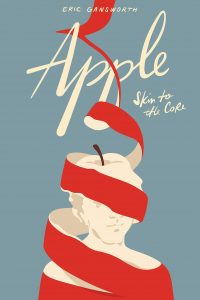
Eric Gansworth, Apple (Skin to the Core)
Levine Querido, October 6
Eric Gansworth’s memoir in verse is easily one of the best books to be published in 2020. The kind of book bound to save lives. It’s a coming of age yarn, a coming out story, for a kid growing up Native, and an elegy all in one, told in gently unfolding verse cliffs that shrug and ease their way into some of the most beautiful lines Gansworth has ever written. Although “Apple (Skin to the Core) is published toward young adults, it recognizes that there’s an untold story here—for many who carried a similar silence into adulthood. “A primary lesson we are taught, even in our greatest sadness,” Gansworth writes in the section on naming: “we must clear our eyes, our ears, our throats to do our parts in carrying on the stories for the time we will no longer be able to pass them on, leaving silent images behind, mere mysteries to others. This is our foundation.” He then concludes. “I tell you here what I have seen, what I have heard, what I have lived. I choose not to be silent, and you can choose to open your ears, and eyes, or close them.” How beautifully this book keeps them open. –John Freeman, Executive Editor

Phil Klay, Missionaries
Penguin Press, October 6
The hotly-anticipated follow-up to National Book Award-winner and Iraq War veteran Phil Klay’s 2015 short story collection, Redeployment, this debut novel looks to be another fascinating window into the murky nature of modern U.S. warfare, this time set in Columbia. Examining “the globalization of violence through the interlocking stories of four characters and the conflicts that define their lives,” Missionaries focuses on the intertwining journeys of a U.S. Army Special Forces medic, a foreign correspondent, a Colombian officer, and lieutenant in a local militia. Expect another clear-eyed and harrowing glimpse into America’s Forever Wars. –Dan Sheehan, Book Marks Editor
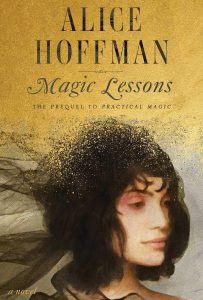
Alice Hoffman, Magic Lessons
Simon & Schuster, October 6
Anyone who knows me knows how much I love Practical Magic. I spend a lot of my time going over the plot in great detail to friends over midnight margaritas. (To recap: the original story follows sister witches who are ostracized by their sleepy town and who are haunted by a family curse that condemns any man who dares love an Owens woman to die.) Unsurprisingly, I’m particularly thrilled that Alice Hoffman has written a prequel to the book that started it all, a quarter of a century later. Magic Lessons tells us the story of Maria Owens, the woman accused of witchcraft in Salem and the matriarch of the Owens family line. The curse (and the cult classic) begins with her, and we finally get to hear her story. –Katie Yee, Book Marks Associate Editor
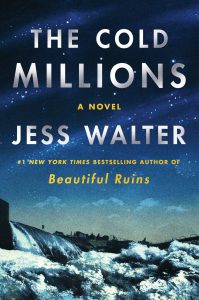
Jess Walter, The Cold Millions
Harper, October 6
It’s been eight years since Walter’s bestselling, sun-soaked Beautiful Ruins, and he doesn’t seem to have gotten any less cinematic in that time: his new novel features two train-hopping brothers, a cougar, a vaudeville singer named Ursula the Great, a mining magnate, and . . . labor leader and activist Elizabeth Gurley Flynn. Okay, I’m interested! –Emily Temple, Managing Editor
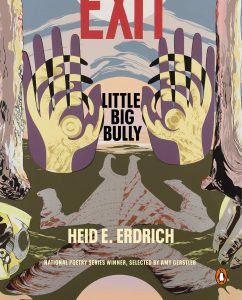
Heid E. Erdrich, Little Big Bully
Penguin, October 6
Erdrich’s vibrant sixth collection begins with an enormous question it then tries in 90 or so ways to answer. “How,” the poems Catherine Wheel of an opener, ends its explosion of riffs on the word how with “How did we come to this.” Little Big Bully expands from this moment, cycling into private moments, public grief, purposefully erased history and Native politics. She finds ways to still chevron the mind sky with wonder, all while cutting lacunae into the poems, spaces of not addressing, or at least addressing what she cannot or will not explain. “[C]reepy the way they want in,” she writes in one poem, “they want in us—inside us/want to dress in our dead/to wear our past and skins/dispossess us again.” The improvisational torque of Little Big Bully means the book is always moving, into imagined story cycles, love poems, riffs, prose poems so vital it feels like they’ve burst free of punctuation, rather than eschewed it for style. This is a major collection by a writer who deserves an audience a big as the light she’s throwing off. –John Freeman, Executive Editor
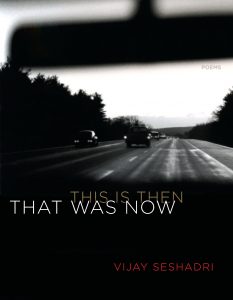
Vijay Seshadri, That Was Now, This Is Then: Poems
Graywolf, October 6
Who can say where and when we are now? “Now is then, / now happened then, and then again,” writes Vijay Seshadri in his intellectually nimble new collection, which reads like a warning to readers that in ways real and emotional. This cycle of nonsense he imagines “is going to happen again, and then again.” So many of the poems here chart the bewilderment of our epistemological unraveling. Yes, we live in a world of robocalls and floating antecedents, of vagueness and drift.
But in the middle part of the book edges surprisingly and powerfully into elegy. For once in a book which carries a loss we are caught nearly as off-guard as the speaker appears to have been. “It is what it is,” Sesadri writes was his father’s favorite phrase. Can one live in timelessness of such an aftermath? Are we all in a cycle of repetition? Out of such a repeat cycle comes boredom and grief; but also a tedium that can lead to violence.
In its latter poems, Sesahdri’s collection edges toward rhetoric of contemporary tribalism, the way it builds towards definitions of againstness. In “The Idol of the Tribe,” he approaches the yoked rhyming fury of James Fenton.
I look at you with my vexed eye.
I look at you with my hostile eye.
I look at you with my hostile and vexed eye.
My hostile, vexed eye is a wrench.
My vexed eye is a socket wrench.
My vexed and hostile socket-wrench eye twists
the bolt that hinges your mandible free
from its frozen grooves.
You scream, but we go on turning,
I and my eye. I know what I’m into.
I know what I’ve been put here for.
Seshadri’s syntactical dexterity, the sheer variety of his tonal registers means he has made a book that refuses handling; it will not be used as a weapon. In fact it feels designed not to be, all the parts which could allow you to swing it are missing. What remains is smooth and unique and self-contained, flashes made inside and shared here discreetly, briefly—like something put down “by the light of a taper, deep inside yourself, at your walnut secretary.” And yet it has such power and unease, you may leave it feeling less alone. –John Freeman, Lit Hub Executive Editor
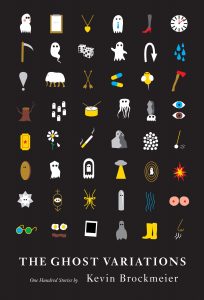
Kevin Brockmeier, The Ghost Variations
Pantheon, October 6
Kevin Brockmeier’s lyrical science fiction is always a welcome retreat from the present, so I can’t wait to read his new collection of 100 miniature ghost stories. Small slices of literary haunting seem just right for the moment. –Jessie Gaynor, Lit Hub Social Media Editor
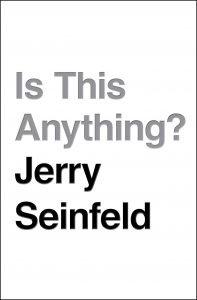
Jerry Seinfeld, Is This Anything?
Simon & Schuster, October 6
For this book, Seinfeld has selected his favorite comedic material from the last twenty-five years—so I think it’s a pretty fair bet that yes, it’s something. –Emily Temple, Managing Editor
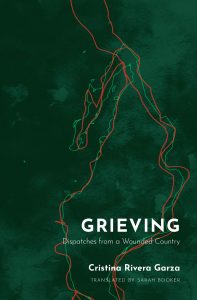
Cristina Rivera Garza, Grieving
Feminist Press, October 6
Cristina Rivera Garza’s Grieving is about the systemic violence enacted along the US–Mexico border. What happens in between these two places? How can we even attempt to make sense of the corruption? How can we begin to make it better? It is fitting that the structure of this collection is a beautiful hybrid of things: journalism, personal essay, political analysis, horror theory—yes, horror theory! Cristina Rivera Garza is particularly adept at weaving together these things, at examining the atrocities inflicted on her country under different lights. I will leave you with this line: “Writing as we grieve, grieving as we write: a practice able to create refuge from the open.” –Katie Yee, Book Marks Associate Editor
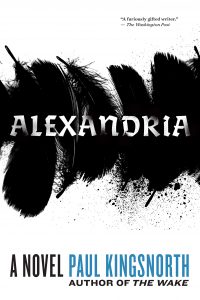
Paul Kingsnorth, Alexandria
Graywolf, October 6
If you’ve never heard of Paul Kingsnorth (Beast, The Wake), you really should look him up. He’s quite a character. The novelist, poet, and environmentalist was once the deputy editor of The Ecologist, before he retired from journalism to set up The Dark Mountain Project, an off-the-grid writers’ and artists’ movement “designed to question the stories our culture is telling itself in a time of ecological and social unravelling.” Set over one thousand years from now, on the far side of an apocalypse, in what was once the eastern part of England, Alexandria is about a small religious community of survivors who find themselves stalked by a mysterious force. –Dan Sheehan, Book Marks Editor

Brian Selfon, The Nightworkers
MCD, October 6
I just finished reading The Nightworkers by Brian Selfon and thought that it was absolutely brilliant. Uncle Shecky runs a money-laundering business with his artistic nephew Henry, and his bookloving niece Kerasha, who has just gotten out of a six-year stint in prison for thieving, has moved into the family home. The patchwork family may be criminals, but they sit down every night for a home-cooked dinner. Henry brings his friend Emil in as a money-runner, but when Emil goes missing along with a $250,000 drop, and Kerasha notices that their Bushwick apartment is under surveillance, Shecky’s carefully wrought life starts to fall apart. Each character is complex and beautifully drawn, and the ending was genuinely surprising. There’s art, theft, tight family bonds, and intricate plotting—it’s really got everything. Also it takes place in my neighborhood, and one of the characters goes to the farmer’s market that I always sleep through! –Molly Odintz, CrimeReads Senior Editor
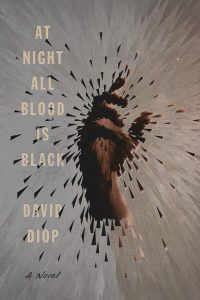
David Diop, tr. Anna Moschovakis, At Night All Blood is Black
FSG, October 6
Diop’s English-language debut, which won the Prix Goncourt des Lycéens, is a historical novel about a Senegalese man fighting with the French during WWI, who, disturbed by his own ability to put a dying friend out of his misery, begins a strange siege on the German forces: sneaking across enemy lines, and coming back with an enemy’s hand. Viet Thanh Nguyen called it “an unrelenting take on war, race, masculinity, and colonialism. Most of all, Diop’s short, sharp, and serrated novel is a visceral dramatization of how our humanity and inhumanity are forever intertwined.” Also, not for nothing, but I can’t take my eyes off the cover. –Emily Temple, Managing Editor

Keisha Bush, No Heaven for Good Boys
Random House, October 13
What an umbrella of protection faith offers, if you have it, or, until it’s exploited, as happens in Keisha Bush’s powerful, Dickensian debut novel, No Heaven for Good Boys. Set in Senegal, it tells the tale of a young boy named Ibrahimah growing up in a rural village, beloved of his mother, who runs home and to the sea every day after school. After he is spotted by a well known Koranic teacher, he is sent by his family to study in what is called a Daraas in Dakar, one of the many institutions which lead back to the 11th century, when Islam came to what is now Senegal. All highly promising for a village boy, but instead of being cared for and loved the way children should be—he is sent out into the streets to beg, and worse. Although a cousin of his is there, too, this being a coming of age tale, Ibrahimah must rely on wit, luck, and the ability to weather what fate throws at him, which is a lot, to survive. Bush is a born storyteller, who knows how to speak in the language of the boys she brings to life. They are hungry and they want love—the latter being the word most often used in this devastating, drawn from real events, story. –John Freeman, Lit Hub Executive Editor
Sarah Smarsh, She Come By It Natural: Dolly Parton and the Women Who Live Her Songs
Scribner, October 13
I had a lot of driving to do last year and was kept wonderful company in my beat-up 2006 Ford Ranger by Sarah Smarsh reading her terrific memoir Heartland. It’s not easy to blend intimate family history, contemporary reporting, and searing analyses of American class iniquity, but Smarsh pulled it off (I want to say it’s the anti-Hillbilly Elegy, but that elevates JD Vance a bit too much for my taste). Some of the hardluck scenes in Heartland read like old country songs, and it’s easy to imagine Dolly Parton pulling out that perfect detail to illustrate the defiance and tenacity demanded of so many women just to get from one paycheck to the next. Parton’s journey through the stations of American class has been long and hard, and I can think of no one better than Smarsh to map its battles, its tragedies, and its triumphs. –Jonny Diamond, Lit Hub Editor-in-Chief

Éireann Lorsung, The Century
Milkweed Editions, October 13
One question poet Éireann Lorsung asks in her new collection, The Century, is how citizens contribute to societal structures of violence and control. Slavery in the US and the Holocaust are but two of the most glaring examples. Lorsung’s collection comes at a time when studies about the roles average people played in the perpetuation of Nazism and Italian Fascism abound, to say nothing of the “minor” violences that often define interpersonal relationships across lines of color, gender, creed, and more. –Aaron Robertson, Assistant Editor
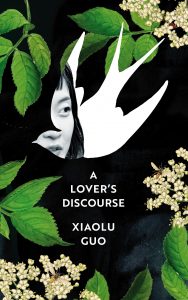
Xiaolu Guo, A Lover’s Discourse
Grove, October 13
With a nod to Roland Barthes, Xiaolu Guo shows us a different lover’s discourse: a portrait of a relationship told through conversations between a Chinese grad student and an Australian man in London. Not only is Xiaulu Guo a great novelist (she was also shortlisted for the Orange Prize for her novel, A Concise Chinese-English Dictionary for Lovers), but she is also a filmmaker. She gives her careful eye and her wonderful ear for dialogue to this love story, this exploration of what it looks, sounds, and feels like to merge two cultures and two lives together. –Katie Yee, Book Marks Associate Editor
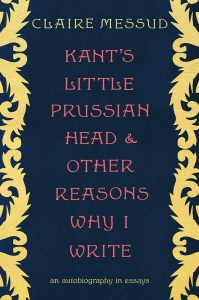
Claire Messud, Kant’s Little Prussian Head and Other Reasons Why I Write: An Autobiography Through Essays
Norton, October 13
If you’ve read Claire Messud’s warmly globe-trotting fiction, from When the World Was Steady to The Emperor’s Children, you’ve sensed the ghost trail of a life spent in motion. This fabulous collection of essays tells the tale behind this arc, from her grandparents movements into and across France, mimicking those of Camus in that time, to her own father’s long and elaborate life as a kind of living footnote of the collapse of the Ottoman Empire. Messud writes like a novelist, disappearing into the details of their lives—even, in the case of her father, when he was departing. This reflexive desire to go in rather than peer in a mirror and see herself, even when borrowing from the material of life, makes Messud a tremendously generous and inquisitive reader, as the pieces in this book on Jane Bowles, Marguerite Duras, Valeria Luiselli and Yasmine El Rashidi reveal. Would that she did more of it. Among living novelists, only Aminatta Forna and Zadie Smith write this well across the essay and the novel. –John Freeman, Lit Hub Executive Editor

John Berryman, ed. Philip Coleman and Calisa McRae, The Selected Letters of John Berryman
Harvard University Press, October 13
Editors Philip Coleman and Calista McRae have put together the first collection of poet John Berryman’s correspondence with friends, family, writers, and others in the publishing world. Berryman exchanged letters with the very best: Ezra Pound, Adrienne Rich, Robert Lowell, and many others. This is an unmissable book for those interested in the development of American literary culture after World War II. –Aaron Robertson, Assistant Editor
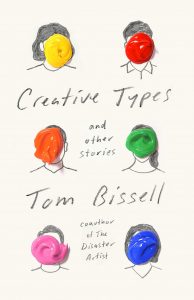
Tom Bissell, Creative Types: and Other Stories
Pantheon, October 13
Like many readers, I was introduced to Bissell through his nonfiction and longform journalism; I particularly loved Magic Hours, his book about, broadly, creativity, and of course it was Bissell who wrote the definitive work on The Room, The Disaster Artist, which was later adapted into a surprisingly good film starring James Franco. Creative Types is a short story collection, his second (of ten books!), and I have no doubt it will be just as sharp-eyed and brilliant as the rest of his writing. –Emily Temple, Managing Editor
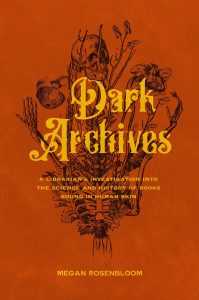
Megan Rosenbloom, Dark Archives: A Librarian’s Investigation Into the Science and History of Books Bound in Human Skin
FSG, October 20
Megan Rosenbloom’s foray into the world of books bound in human skin was one of the most surprisingly humanist and moving works of nonfiction I have ever come across. Rosenbloom is a medical ethicist librarian long affiliated with the death positivity movement, which I had never heard of until I came across this text and now desperately want to be a part of, and she leads workshops all over the country for the Order of the Good Death. Her interest in books bound in human skin was rewarded a few years ago when Harvard labs came up with a new method of scientifically determining if the binding of a book was in fact made of human skin. Megan Rosenbloom then went on an odyssey around the world to once and for all confirm the origins of those books rumored to have a binding of human origin. Results were surprising—most of the confirmed bindings were medical texts, bound by doctors in the 19th century, at a strange moment in time when artisan tanneries still operated but medical professionals had begun to be consumed by the medical distancing that allows one to bind a book in a dead patient’s skin, and still threatens the medical world today. The biggest surprise for me? That a book could include the words “What a beautiful flayed penis!” and end up as a gorgeous piece of writing on ethics and consent (with, of course, a visit to a modern tannery). –Molly Odintz, CrimeReads Senior Editor
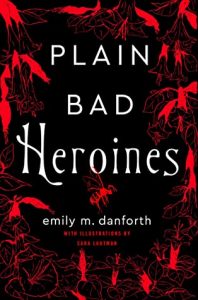
emily m. danforth, Plain Bad Heroines
William Morrow, October 20
The galley of danforth’s first novel for adults comes with a little sleeve that prevents you from opening it right away. “From books with smiling heroines, chivalrous young men, and happy endings, oh Kind Devil,” it says, “deliver me.” It also comes with a faux-replica of a 1902 edition of The Providence Daily warning of outbreaks of “MacLaneism, a condition of romantic irrationality and sometimes degeneracy acutely affecting young ladies,” spurred by the works of Mary MacLane, “untamed young authoress from Montana.” I don’t know about you, but I’m sold—and even more so by the publisher’s description of the book as “The Favorite meets The Haunting of Hill House” (I mean, yep) and the many weird and beautiful illustrations inside. This one goes right to the top of my list. –Emily Temple, Managing Editor
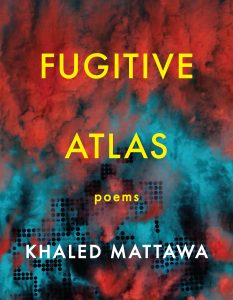
Khaled Mattawa, Fugitive Atlas
Graywolf, October 20
One day these gorgeous poems will make an opera, a play, even, surely, a film. The way they beg for adaption is not a sign of their in completeness, however, but rather how powerful a chorus of voices Mattawa has created on the page. Here in song and verse are people caught in the anguished network of migration across the Mediterranean, from the smuggled to the smugglers, from mothers to children to people left behind. Here is a landscape in which war abets climate destruction, and that unraveling expels whole families from their villages, homes, their lives.
In spite of images from such flights being available to all, the staggering apathy—or outright hostility—explains the word fugitive in their title. So many of the characters Mattawa writes on are double fugitives, from one home, and from the other they seek. Mattawa, one of the finest translators from Arabic alive today, has managed to write into English the tonal address the best poems from that language attain—such as Darwish and Mersal, both of whom Mattawa has translated. Their voices soar and cry out, they go directly to the core of the body. –John Freeman, Executive Editor
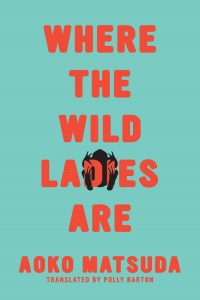
Aoko Matsuda, tr. Polly Barton, Where the Wild Ladies Are
Soft Skull, October 20
As someone more than a little obsessed with fairy tales and fables, and actually ancient lore of all kinds, I am very much anticipating this book of feminist retellings of traditional Japanese folktales from the author of The Girl Who Is Getting Married, which The Guardian calls “funny, beautiful, surreal and relatable.” –Emily Temple, Managing Editor
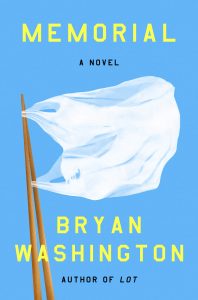 Bryan Washington, Memorial
Bryan Washington, Memorial
Riverhead, October 27
Bryan Washington’s 2019 short story collection Lot (which won the Dylan Thomas Prize and the Ernest J. Gaines Award for Literary Excellence) ended up being one of the most acclaimed debuts of recent years, and with good reason. The Houston-set collection was a brilliant, kaleidoscopic portrait of an entire community. Memorial, a novel also set in Washington’s native Houston, is a funny and joyful love story about two men—a Japanese American chef at a Mexican restaurant and a Black day care teacher—which Ocean Vuong has said “feels like a new vision for the 21st century novel.” –Dan Sheehan, Book Marks Editor

Carlo M. Cipolla, The Basic Laws of Human Stupidity
Doubleday, October 27
In which an economist explores the five laws that govern so much of our current experience, most of which you probably already know. These are the laws of human stupidity. They go like this:
1. Everyone underestimates the number of stupid individuals among us.
2. The probability that a certain person is stupid is independent of any other characteristic of that person.
3. A stupid person is a person who causes losses to another person while deriving no gain and even possibly incurring losses themselves.
4. Non-stupid people always underestimate the damaging power of stupid individuals.
5. A stupid person is the most dangerous type of person.
Help. –Emily Temple, Managing Editor
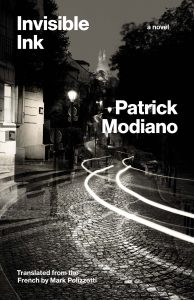
Patrick Modiano, tr. Mark Polizzotti, Invisible Ink
Yale University Press, October 27
Patrick Modiano returns to the detective form he used with such metaphysical effect in Dora Bruder with his 29th novel, the swift tale a private detective who has reopened a cold case of a missing woman, thirty years after he failed to solve it. Unfolding in the form of Jean’s diary, the written-ness of this account is part of its mode of investigation, its slight of hand. Its subject. Jean, after all, is Modiano’s given birth name, and details from a half dozen of his other works appear like faces seen from a rain-blurred taxi window. Has he written himself any nearer to the source of his quest, Jean wonders—or is it merely like all of it were penned in invisible ink, not even visible to the writer? The one searching? Once again, even when calling attention to the questions which pipe out his trademark mists, Modiano manages to make them yet again, as powerfully as ever. –John Freeman, Executive Editor

Edward Carey, The Swallowed Man
Riverhead, October 27
Edward Carey’s new novel reimagines the story of Pinocchio, and I can’t imagine a better showcase for his considerable talents—in both literary and visual arts. I look forward to a fabulous fabulist journey though one of the less-plumbed fairytales, accompanied by some breathtaking illustrations. –Jessie Gaynor, Lit Hub Social Media Editor


